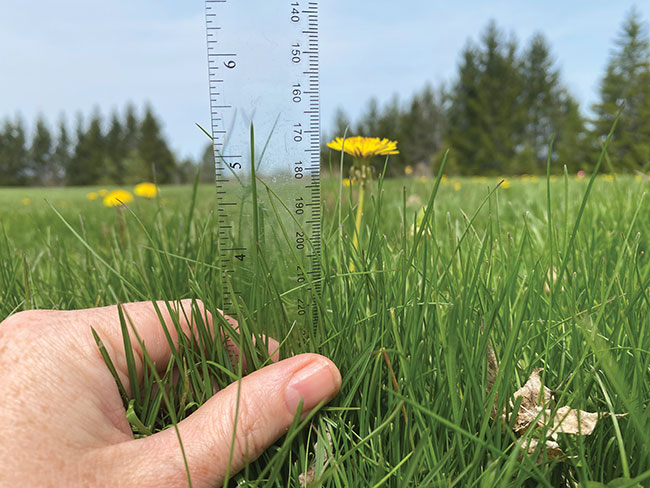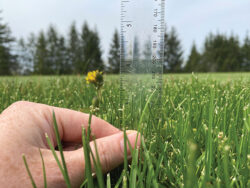
Features
Eco-Friendly Practices
Turf Revival
Guelph Turfgrass Institute weighs in on No Mow May’s shortcomings
Institute instead recommends #Know2MowMay over #NoMowMay
June 12, 2023 By Dr. Sara Stricker

An initiative sprang up in the United Kingdom in 2019 and was officially dubbed “No Mow May” by the conservation charity PlantLife. The theory was that roadsides, lawns, and parks could provide an early-season food source through the flowering weeds such as dandelions. This year, the Guelph Turfgrass Institute (GTI) was asked to weigh in on this topic and share recommendations based on science.
Dr. Eric Lyons, Dr. Katerina Jordan, and I spoke to various media platforms, and they raised several great questions.
Why do we mow grass?
The establishment of permanent structures and property lines in North America links back to colonization by European settlers. The mowed lawns that exist today are functioning to reduce mice, biting/stinging insects, and noxious weeds from establishing next to our homes. Mowing grassy areas next to buildings also prevents the establishment of woody trees and bushes since roots can damage foundations and branches can damage roofs.
Why does the GTI support a non-native monoculture (turfgrass)?
The research at the GTI aims to improve the sustainability of turfgrass. When we refer to turfgrass, it means a stand of grass which has a functional purpose. This includes parks for recreation and cooling the surrounding community, sports fields for fitness and the economics of minor and major league teams, roadsides for safety and visibility, and lawns for kids and dogs and social gatherings. Turfgrass species have been selectively bred over time to tolerate traffic, play, and mowing.
The researchers at the GTI are not enforcing pristine monoculture grass for every homeowner, and, in fact, we suggest adding mowing-tolerant flowers to some lawns to increase biodiversity and support pollinators. Depending on the hardiness zone, homeowners could add creeping buttercup, English daisy, wild strawberry, crocus, or snowdrop into an existing lawn to provide pollen and nectar resources.
These species can be mowed to maintain the buffering function of lawns around homes, preventing the establishment of pest species and noxious weeds. It’s important to note that these flowering species are less tolerant to traffic and are not recommended for sport fields or areas where kids and pets are playing.
The argument against turfgrasses as “non-native species” again links back to colonization. When our cities and towns were mapped out by urban planners, they brought with them European species (grasses) to create mowed buffers between buildings and functional green spaces. Instead of thinking about “native-ness,” I suggest thinking about functionality, because no one is complaining that most crops grown in Canada originated from around the world. The grasses native to Canada have not been selectively bred over time to tolerate mowing and are not recommended for use as a lawn. However, they are great additions to naturalized areas and gardens. This includes little bluestem, big bluestem, sweetgrass, Canadian wild rye, and switchgrass.
How can grassy areas be more environmentally friendly?
Grassy areas can be low input – requiring no water or fertilizer or chemicals – if the users adjust their expectations. Not every lawn needs to look like a golf course, and each property owner should be allowed to decide how to use their space. If you want a large flower garden and have the resources to create and care for it, then plant a garden. If you want an area to play or have minimal time and effort to devote to gardening, then we recommend grass. A few tips include:
- If you choose to water the grass, do so deeply and infrequently. This encourages deep roots and increases tolerance for drought stress.
- Overseed with drought-tolerant species like tall fescue, but this species is less cold-tolerant than Kentucky bluegrass and may not survive in all Canadian regions.
- Do not remove grass clippings. These add nutrients and organic matter to the soil as they decompose.
- Create a dense stand of turf to out-compete weeds. Overseeding in the spring or fall is recommended.
- In fall, mulch fallen leaves into the turf with a mulching mower to act as a natural fertilizer.
- Hand pick unwanted weeds and add seed into bare patches to prevent future weeds.
Should I stop mowing the dandelions?
 Firstly, dandelions are incomplete pollen sources for our native pollinator species. Next, look around your neighbourhood. If you have a neighbour who has decided to create a dense and weed-free stand of turfgrass, then your dandelion field will likely cause some irritation to that neighbour who may then decide to use more herbicides. Lastly, dandelions are tolerant to mowing, so mowing on a regular basis won’t eliminate them.
Firstly, dandelions are incomplete pollen sources for our native pollinator species. Next, look around your neighbourhood. If you have a neighbour who has decided to create a dense and weed-free stand of turfgrass, then your dandelion field will likely cause some irritation to that neighbour who may then decide to use more herbicides. Lastly, dandelions are tolerant to mowing, so mowing on a regular basis won’t eliminate them.
Preliminary data from our No Mow May experiment suggests that there are similar numbers of flowering dandelions in mowed and unmowed plots. When measured directly after mowing, the flower heads in the mowing treatment were cut off, resulting in a lower number of flowers on May 5. However, the number of flowers was not statistically different between treatments five days later.
When should I cut my grass?
It depends on several factors. Different turfgrass species have different recommended mowing heights. The mowing height is also dependent on the use of the grass and how frequently you are willing to mow. Maintaining the turfgrass at a higher height of cut means you can mow less frequently.
We recommend following “the one-third rule” which states to never remove more than one-third the height of the plant during any mowing event. If your target mowing height is 7.5 centimetres, then you should mow the grass before the turf reaches 11 centimetres tall.
If the grass has been let to grow too tall, it is important not to suddenly cut the turfgrass down in one mowing event. This can result in scalping, where your mowing removes the entire leaf blade and drastically limits the plant’s ability to photosynthesize and grow. In some cases of severe scalping, the crown itself can be damaged, resulting in death of the turfgrass plant and the need for reseeding to re-establish the turf. We recommend to slowly lower the mowing height over time and maintain each successive height for a week or two, until the grass is fully recovered.
How can we support pollinators?
Research from the University of Massachusetts recommends decreasing mowing frequency to support pollinators. Their findings suggest that tall grassy areas (greater than 15 centimetres) limit flowering species through competition and shading. The optimum mowing frequency for bee abundance was every two weeks, when grass was approximately 12.5 centimetres tall, as opposed to weekly or every three weeks. The study cut the grass down to 6.35 centimetres at each mowing event, which is more than the one-third recommended in one mow, so the turf may have been a little stressed. It’s a balancing act between turf health and flowers.
If you want a functional lawn, then you could create a naturalized area on the property which includes tall grass, wildflowers, and decomposing leaves and wood. This would create nesting sites and food sources for bees, butterflies, flies, moths, and other beneficial insects. The key is to have a mowed buffer zone (and possibly a fence) around the naturalized areas to keep dogs and kids safe. Pests like wasps, fleas, and ticks will be just as likely to nest in a naturalized area if given the opportunity.
The GTI aims to offer research, outreach, and education. What we do not want is for a homeowner (who wishes to have a functional lawn in the future) to practice #NoMowMay and then struggle to return their grassland into a lawn in June.
Dr. Sara Stricker is the communications and outreach co-ordinator at the Guelph Turfgrass Institute.
Print this page